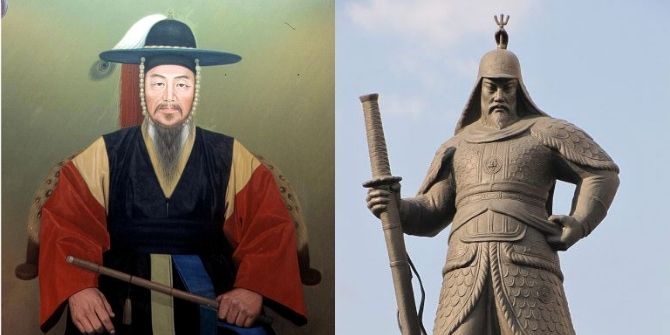Kapanlagi.com - Admiral Yi Sun Shin has done many services in transforming Korea for the better during the Joseon Dynasty until now. Among all his victories in warfare, the Battle of Hansando is not only considered one of Yi's greatest battles, but also one of the four largest naval battles in the world along with the Battle of Salamis (480 BC), the Battle of Calais (1588), and the Battle of Trafalgar (1805). The victory at Hansando proved the superiority of Korean firearms and warships, as well as Yi's brilliance as a naval commander in the use of his creative naval tactics called 'Hagikjin' or the crane wing formation.
However, unfortunately, despite all his efforts and achievements, Admiral Yi, portrayed by Choi Min Sik in the film THE ADMIRAL: ROARING CURRENTS, became involved in domestic political disputes and was eventually stripped of his position as Supreme Commander and escorted to Seoul as a criminal in February 1597. Admiral Yi Sun Shin faced the threat of death penalty after suffering brutal torture, but was eventually freed from prison thanks to the efforts of many people to save his life.
1. 13 Battle Ships against 133 Enemy Ships
As reported by VANK (Voluntary Agency Network of Korea) after being released, he was forced to fight as an ordinary person, which is called 'Baegui Jonggun' punishment in Korean language. What's worse, he lost his beloved mother at that time.
The general who replaced Admiral Yi as the Supreme Commander, General Won Gyun, was defeated and died in the Battle of Chilcheollyang in July 1597. After hearing the news of this crushing defeat, Yi Sun Shin patrolled the coastal areas of Korea with his subordinates for a month in search of a solution to restore the Korean Navy. He also reorganized the scattered troops and gathered weapons and supplies.
On August 3, 1597, he was brought back to lead the navy after receiving an official appointment letter as the Commander of the South Sea Fleet. The bad news was that at that time, there were only 13 Panokseon warships left under his command.
Imagine, with such a small fleet, Admiral Yi had to face 133 enemy ships in the Battle of Myeongnyang. However, despite being outnumbered, he defeated the Japanese with his extraordinary leadership, remarkable tactics, and knowledge of the geographical features of the area. This victory stopped Japan's attempt to advance to the western sea driven by their victory in the Battle of Chilcheollyang.
2. Losing a Child After His Victory
However, this victory caused him to lose his third child as the defeated Japanese forces raided his house in Asan and retaliated against his family. After this incident, Yi Sun Shin focused all his efforts on rebuilding the navy, while relocating his naval base to Gohado, and later to Gogeumdo Island. In Jingbirok, a history of the Imjin War written by Yu Seong Ryong, it is noted that Yi Sun Shin moved his base to Gogeumdo in 1598, with 8000 soldiers and 53 warships.
When the Japanese warlord Toyotomi Hideyoshi died on August 18, 1598, the Japanese forces hastily retreated from Korea. The combined Korean-Chinese fleet pursued the retreating Japanese army and engaged in a final battle off the coast of Noryang in November 1598.
3. The Hero Killed by the Enemy
At this moment is the second when this Korean war hero must be shot by the enemy during the battle, severely wounded and dying. He requested that no one be informed about his death, afraid of its impact on the morale of his troops during the battle.
The Battle of Noryang is one of the greatest victories and most decisive battles that proved the patriotism and supremacy of the Korean Navy. Throughout the Imjin War, Admiral Yi Sun Shin was an undefeated warrior in at least 23 battles under his command for seven years.
Admiral Yi Sun Shin was not only a brilliant commander, but also a true leader who wholeheartedly loved his country and people. He was willing to sacrifice himself to protect them. That is why he became one of the greatest heroes in Korean history and his name will never fade away with time.
You can also watch the story of Admiral Yi Sun Shin in the film THE ADMIRAL: ROARING CURRENTS released in 2014. This film is also the top-grossing and most-watched Korean film in Korea. The film tells the story of how Yi Sun Shin, the admiral, ultimately transformed Korea.
(kpl/mit)
Disclaimer: This translation from Bahasa Indonesia to English has been generated by Artificial Intelligence.





![[KapanLagi Cerita Korea Ep 4] 'Ppalli Ppalli!', Life in Korea That is Always Chased by Time](https://cdns.klimg.com/resized/646x323/p/headline/kapanlagi-cerita-korea-ep-4-ppalli-ppal-fe127b.jpg)

![[KapanLagi Cerita Korea Ep 3] Korea that is All Easy: Living Conveniently in the Land of Ginseng](https://cdns.klimg.com/resized/646x323/p/headline/kapanlagi-cerita-korea-ep-3-korea-yang--0ee9f5.jpg)
![[KapanLagi Cerita Korea Ep 2] 'Jogeumman Juseyo', Learning Korean Language to Reject Bullseye Eggs while Studying in the Land of Ginseng](https://cdns.klimg.com/resized/646x323/p/headline/kapanlagi-cerita-korea-ep-2-2268364732j-d2a41b.jpg)
![[KapanLagi Cerita Korea Ep 1] Biggest Initial Culture Shock in Korea: Learning Like in the Drama 'SKY CASTLE'](https://cdns.klimg.com/resized/646x323/p/headline/kapanlagi-cerita-korea-culture-shock-te-362b03.jpg)


